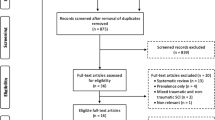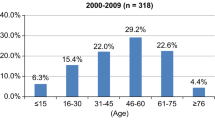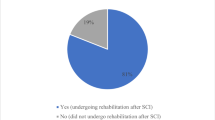Abstract
Study design:
A multicenter prospective cohort study.
Objective:
To compare the demographic data of the included population with other studied spinal cord injury (SCI) populations in the international literature.
Setting:
Eight Dutch rehabilitation centers with a specialized SCI unit.
Methods:
A total of 205 individuals with SCI participated in this study. Information about personal, lesion and rehabilitation characteristics were collected at the beginning of active rehabilitation by means of a questionnaire.
Results:
The research group mainly consisted of men (74%), of individuals with a paraplegia (59%), and had a complete lesion (68%). The SCI was mainly caused by a trauma (75%), principally due to a traffic accident (42%). The length of clinical rehabilitation varied between 2 months and more than a year, which seemed to be dependent on the lesion characteristics and related comorbidity.
Conclusions:
The personal and lesion characteristics of the subjects of the multi-center study were comparable to data of other studies, although fewer older subjects and subjects with an incomplete lesion were included due to the inclusion criteria ‘age’ and ‘wheelchair-dependent’. The length of stay in rehabilitation centers in The Netherlands was longer compared to Denmark but much longer than in eg Australia and the USA.
Similar content being viewed by others
Log in or create a free account to read this content
Gain free access to this article, as well as selected content from this journal and more on nature.com
or
References
van Asbeck FWA . Functioneren met een dwarslaesie, 1987 RU Groningen.
Beck D, Buck M, Pons C . De Revalidatie van dwarslaesiepatienten. De Tijdstroom: Utrecht 1997.
Whiteneck G . Aging with spinal cord injury. Demos Publications: New York 1993.
Dearwater SR, LaPorte RE, Robertson RJ, Brenes G, Adams LL, Becker D . Activity in the spinal cord-injured patient: an epidemiologic analysis of metabolic parameters. Med Sci Sports Exerc 1986; 18: 541–544.
Noreau L, Shephard RJ . Spinal cord injury, exercise and quality of life. Sports Med 1995; 20: 226–250.
Dallmeijer AJ, van der Woude LH, Hollander AP, van As HH . Physical performance during rehabilitation in persons with spinal cord injuries. Med Sci Sports Exerc 1999; 31: 1330–1335.
Lucke KT, Coccia H, Goode JS, Lucke JF . Quality of life in spinal cord injured individuals and their caregivers during the initial 6 months following rehabilitation. Qual Life Res 2004; 13: 97–110.
MacPhee AH, Kirby RL, Coolen AL, Smith C, MacLeod DA, Dupuis DJ . Wheelchair skills training program: A randomized clinical trial of wheelchair users undergoing initial rehabilitation. Arch Phys Med Rehabil 2004; 85: 41–50.
Seelen HA, Potten YJ, Drukker J, Reulen JP, Pons C . Development of new muscle synergies in postural control in spinal cord injured subjects. J Electromyogr Kinesiol 1998; 8: 23–34.
Becker BE, DeLisa JA . Model Spinal Cord Injury System trends, and implications for the future. Arch Phys Med Rehabil 1999; 80: 1514–1521.
Dallmeijer AJ et al. Hand-rim wheelchair propulsion capacity during rehabilitation of persons with spinal cord injury. J Rehabil Res Dev 2005; 42: 55–64.
de Groot S et al. Course of gross mechanical efficiency in handrim wheelchair propulsion during rehabilitation of people with spinal cord injury: a prospective cohort study. Arch Phys Med Rehabil 2005; 86: 1452–1460.
Kilkens OJ, Post MW, Van Der Woude LH, Dallmeijer AJ, van den Heuvel WJ . The wheelchair circuit: reliability of a test to assess mobility in persons with spinal cord injuries. Arch Phys Med Rehabil 2002; 83: 1783–1788.
Kilkens OJ, Post MW, Dallmeijer AJ, Seelen HA, Van Der Woude LH . Wheelchair skills tests: a systematic review. Clin Rehabil 2003; 17: 418–430.
Kilkens OJ, Dallmeijer AJ, De Witte LP, Van Der Woude LH, Post MW . The Wheelchair Circuit: Construct validity and responsiveness of a test to assess manual wheelchair mobility in persons with spinal cord injury. Arch Phys Med Rehabil 2004; 85: 424–431.
Kilkens OJ, Post MW, Dallmeijer AJ, Van Asbeck FW, Van Der Woude LH . Relationship between manual wheelchair skill performance and participation of persons with spinal cord injuries 1 year after discharge from inpatient rehabilitation. J Rehabil Res Dev 2005; 42: 65–74.
Kilkens OJ, Dallmeijer AJ, Nene AV, Post MW, Van Der Woude LH . The longitudinal relation between physical capacity and wheelchair skill performance during inpatient rehabilitation of people with spinal cord injury. Arch Phys Med Rehabil 2005; 86: 1575–1581.
Kilkens OJ, Dallmeijer AJ, Angenot E, Twisk JW, Post MW, Van Der Woude LH . Subject- and injury-related factors influencing the course of manual wheelchair skill performance during initial inpatient rehabilitation of persons with spinal cord injury. Arch Phys Med Rehabil 2005; 86: 2119–2125.
van Drongelen S et al. Upper extremity musculoskeletal pain during and after rehabilitation in wheelchair-using persons with a spinal cord injury. Spinal Cord 2006; 44: 152–159 [E-pub ahead of print: 6 September 2005; doi:10.1038/sj.sc.3101826].
Post MWM . Living with spinal cord injury. A study of health status and life satisfaction of independently living people with a spinal cord injury. Universiteit Utrecht 1997.
Marino R et al. International Standards for Neurological Classification of spinal cord injury, vol. revised 2000. American Spinal Injury Association: Chicago, IL 2000.
van Asbeck FW, Post MW, Pangalila RF . An epidemiological description of spinal cord injuries in The Netherlands in 1994. Spinal Cord 2000; 38: 420–424.
Schönherr MC, Groothoff JW, Mulder GA, Eisma WH . Rehabilitation of patients with spinal cord lesions in The Netherlands: an epidemiological study. Spinal Cord 1996; 34: 679–683.
Raadsen HP, van Asbeck FWA . Over leven met een dwarslaesie. Revalidatiecentrum De Hoogstraat: Utrecht 1990.
Biering-Sorensen E, Pedersen V, Clausen S . Epidemiology of spinal cord lesions in Denmark. Paraplegia 1990; 28: 105–118.
Campos da Paz A, Beraldo PS, Almeida MC, Neves EG, Alves CM, Khan P . Traumatic injury to the spinal cord. Prevalence in Brazilian hospitals. Paraplegia 1992; 30: 636–640.
Celani MG, Spizzichino L, Ricci S, Zampolini M, Franceschini M . Spinal cord injury in Italy: a multicenter retrospective study. Arch Phys Med Rehabil 2001; 82: 589–596.
Garcia-Reneses J, Herruzo-Cabrera R, Martinez-Moreno M . Epidemiological study of spinal cord injury in Spain 1984–1985. Paraplegia 1991; 28: 180–190.
Hart C, Williams E . Epidemiology of spinal cord injuries: a reflection of changes in South African society. Paraplegia 1994; 32: 709–714.
Maharaj JC . Epidemiology of spinal cord paralysis in Fiji: 1985–1994. Spinal Cord 1996; 34: 549–559.
Martins F, Freitas F, Martins L, Dartigues JF, Barat M . Spinal cord injuries – epidemiology in Portugal's central region. Spinal Cord 1998; 36: 574–578.
Nobunaga AI, Go BK, Karunas RB . Recent demographic and injury trends in people served by the Model Spinal Cord Injury Care Systems. Arch Phys Med Rehabil 1999; 80: 1372–1382.
Post MW, De Witte LP, van Asbeck FW, van Dijk AJ, Schrijvers AJ . Predictors of health status and life satisfaction in spinal cord injury. Arch Phys Med Rehabil 1998; 79: 395–401.
Silberstein B, Rabinovich S . Epidemiology of spinal cord injuries in Novosibirsk, Russia. Paraplegia 1995; 33: 322–325.
Soopramanien A . Epidemiology of spinal injuries in Romania. Paraplegia 1994; 32: 715–722.
Ronen J et al. Length of stay in hospital following spinal cord lesions in Israel. Spinal Cord 2004; 42: 353–358.
Tooth L, McKenna K, Geraghty T . Rehabilitation outcomes in traumatic spinal cord injury in Australia: functional status, length of stay and discharge setting. Spinal Cord 2003; 41: 220–230.
Eastwood EA, Hagglund KJ, Ragnarsson KT, Gordon WA, Marino RJ . Medical rehabilitation length of stay and outcomes for persons with traumatic spinal cord injury – 1990–1997. Arch Phys Med Rehabil 1999; 80: 1457–1463.
Acknowledgements
We thank the eight participating rehabilitation centers and especially the research assistants for collecting all the data: Sacha van Langeveld (De Hoogstraat, Utrecht), Annelieke Niezen/Peter Luthart (Rehabilitation Center Amsterdam), Marijke Schuitemaker (Het Roessingh, Enschede), Karin Postma (Rijndam Revalidatiecentrum, Rotterdam), Jos Bloemen (Hoensbroeck Revalidatiecentrum, Hoensbroek), Hennie Rijken (Sint Maartenskliniek, Nijmegen), Ferry Woldring (Beatrixoord, Haren), and Linda Valent (Heliomare, Wijk aan Zee). This study was supported by the Dutch Health Research and Development Council, ZON-MW Rehabilitation program, Grant no. 1435.0003.
Author information
Authors and Affiliations
Rights and permissions
About this article
Cite this article
de Groot, S., Dallmeijer, A., Post, M. et al. Demographics of the Dutch multicenter prospective cohort study ‘Restoration of mobility in spinal cord injury rehabilitation’. Spinal Cord 44, 668–675 (2006). https://doi.org/10.1038/sj.sc.3101906
Published:
Issue date:
DOI: https://doi.org/10.1038/sj.sc.3101906
Keywords
This article is cited by
-
Eye-tracking control of an adjustable electric bed: construction and validation by immobile patients with multiple sclerosis
Journal of NeuroEngineering and Rehabilitation (2023)
-
Real-time motion onset recognition for robot-assisted gait rehabilitation
Journal of NeuroEngineering and Rehabilitation (2022)
-
Risk indicators of length of acute hospital stay after traumatic spinal cord injury in South Africa: a prospective, population-based study
Spinal Cord (2019)
-
Mental health and life satisfaction of individuals with spinal cord injury and their partners 5 years after discharge from first inpatient rehabilitation
Spinal Cord (2018)
-
Prevalence of parenthood in wheelchair-dependent persons with long-term spinal cord injury in the Netherlands
Spinal Cord (2018)



